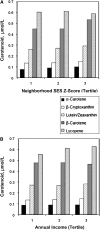Neighborhood socioeconomic status is associated with serum carotenoid concentrations in older, community-dwelling women
- PMID: 21178091
- PMCID: PMC3021448
- DOI: 10.3945/jn.110.129684
Neighborhood socioeconomic status is associated with serum carotenoid concentrations in older, community-dwelling women
Abstract
A high dietary intake of fruit and vegetables has been shown to be protective for health. Neighborhood socioeconomic differences may influence the consumption of carotenoid-rich foods, as indicated by serum carotenoid concentrations. To test this hypothesis, we examined the relationship between neighborhood socioeconomic status (SES) and serum carotenoid concentrations in a population-based sample of community-dwelling women, aged 70-79 y, who participated in the Women's Health and Aging Study II in Baltimore, Maryland. Neighborhood socioeconomic Z-scores were derived from characteristics of the census block of the participants. Serum carotenoid concentrations were measured at baseline and at 18, 36, 72, 98, and 108 mo follow-up visits. Neighborhood Z-scores were positively associated with serum α-carotene (P = 0.0006), β-carotene (P = 0.07), β-cryptoxanthin (P = 0.03), and lutein+zeaxanthin (P = 0.004) after adjusting for age, race, BMI, smoking, inflammation, and season. There was no significant association between neighborhood Z-score and serum lycopene. Older, community-dwelling women from neighborhoods with lower SES have lower serum carotenoid concentrations, which reflect a lower consumption of carotenoid-rich fresh fruits and vegetables.
Conflict of interest statement
Author disclosures: E. J. Nicklett, S. Szanton, K. Sun, L. Ferrucci, L. P. Fried, J. M. Guralnik, R. D. Semba, no conflicts of interest.
Figures

References
-
- Food and Nutrition Board, Institute of Medicine Dietary reference intakes for vitamin C, vitamin E, selenium, and carotenoids. Washington, DC: National Academies of Science; 2000 - PubMed
-
- Yeum KJ, Booth SL, Sadowski JA, Liu C, Tang G, Krinsky NI, Russell RM. Human plasma carotenoid response to the ingestion of controlled diets high in fruits and vegetables. Am J Clin Nutr. 1996;64:594–602 - PubMed
-
- Maiani G, Castón MJP, Catasta G, Toti E, Cambrodón IG, Bysted A, Granado-Lorencio F, Olmedilla-Alonso B, Knuthsen P, et al. Carotenoids: actual knowledge on food sources, intakes, stability and bioavailability and their protective role in humans. Mol Nutr Food Res. 2009;53:S194–218 - PubMed
-
- Semba RD, Blaum C, Guralnik JM, Moncrief DT, Ricks MO, Fried LP. Carotenoid and vitamin E status are associated with indicators of sarcopenia among older women living in the community. Aging Clin Exp Res. 2003;15:482–7 - PubMed
Publication types
MeSH terms
Substances
Grants and funding
LinkOut - more resources
Full Text Sources

